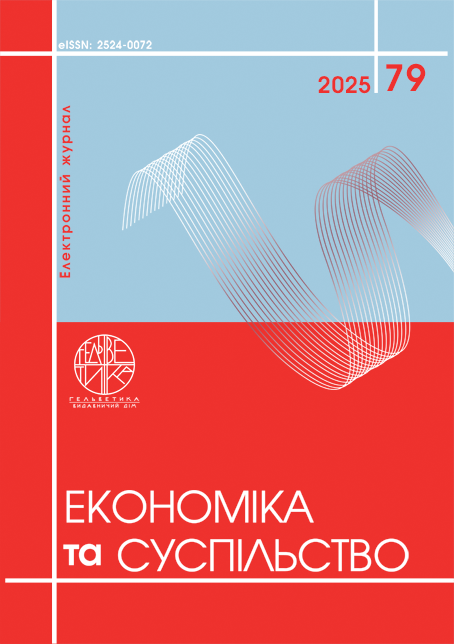THE ROLE OF FOREIGN INVESTMENT IN THE DEVELOPMENT OF THE BALTIC STATES’ FOREIGN TRADE RELATIONS
Abstract
The article substantiates the need to build an evidence base regarding the causal relationship between foreign direct investment (FDI) and the export performance of the Baltic States, taking into account sectoral and technological specificities, the role of innovation (GERD/BERD), and integration into global value chains, as well as in formulating applied policy recommendations for linking FDI with export modernization. Based on data from Eurostat/Comext, UNCTADstat, OECD TiVA, and national banks, a “FDI–innovation–export” panel of indicators has been constructed, and panel models with fixed effects, PPML gravity estimation, and robustness checks have been applied. It is shown that FDI combined with business R&D (BERD) enhances export quality and participation in global value chains: the effect is predominantly positive for Lithuania, neutral-to-positive for Estonia, and limited for Latvia due to import intensity. Recommended tools for linking FDI with innovation include tax incentives, clusters, and export vouchers to maximize the trade multiplier. Price shocks of 2022–2024 and sectoral (NACE) structural differences are additionally considered. It is established that, for the Baltic States, a foreign trade breakthrough occurs when FDI inflows are reinforced by sustainable private R&D investments and institutional incentives (tax support, innovation infrastructure, digital ecosystem). Ultimately, this translates into an expansion of high-tech goods exports and growth of services exports (especially in information and communication technologies). Estonia demonstrates a service-digital trajectory; Lithuania—an acceleration of high-tech exports through integration into GVCs and FDI; while Latvia requires an intensification of BERD and scaling up of innovation incentives to more fully monetize integration into European value chains. The research proposed in the article aims to deepen the theoretical foundations and to determine the most adequate and effective approaches to building an evidence base for the causal link between FDI and export performance of the Baltic States, taking into account sectoral and technological specificities, the role of innovation (GERD/BERD), and integration into global value chains, which may be applied for strategic trade planning of the Baltic States within the single economic space of the European Union.
References
Javorcik B.S. Does FDI Increase the Productivity of Domestic Firms? In Search of Spillovers Through Backward Linkages. The american economic review. Vol. 94. № 3. 2004. Рр. 605–627.
UNCTAD (2025). World Investment Report 2025 – Statistical Annex Tables (FDI flows/stocks by country and region). URL: https://unctad.org/fr/isar/topic/investment/world-investment-report?utm_source (дата звернення: 12.09.2025).
OECD (TiVA). Trade in Value Added Database – Methodology and Indicators of Participation in GVCs (Estonia, Latvia, Lithuania). URL: https://data-explorer.oecd.org/?pg=0&bp=true&tm=%22%28TIVA%29%202025%20edition%22&snb=5 (дата звернення: 12.09.2025).
Quality Report on Balance of Payments, International Investment Position, International Trade in Services and Foreign Direct Investment statistics. Commission staff working document. Brussels, 21.11.2023. 75 р. URL: https://www.eu.dk/samling/20231/kommissionsforslag/swd%282023%290385/forslag/2000359/2784735.pdf?utm_source (дата звернення: 12.09.2025).
IMF (2016). Republic of Lithuania – Selected Issues. URL: https://ec.europa.eu/eurostat/statistics-explained/index.php?dir=prev&offset=20240620144926&title=Special%3ANewFiles%2Fet&utm_source (дата звернення: 12.09.2025).
Іляшенко К.Р. Глобальна мережевізація та участь України у глобальних ланцюгах доданої вартості. Збірник наукових праць ЧДТУ. 2020. Вип. 58. С. 42–51.
Азаренкова Г.М., Головко О.Г., Орєхова К.В. Гнип Н.О., Клепікова С.В. Залучення іноземних інвестицій в економічну систему України Фінансово-кредитна діяльність: проблеми теорії і практики. 2020. Том 4. № 35. С. 129–136.
Нестеров С.В. Участь України у глобальних ланцюгах створення вартості та інвестиційний клімат. Економіка і організація управління. 2023. № 1 (49). С. 163–169.
OECD Economic Surveys: Estonia 2024. Vol. 12. 2024. 128 р. OECD URL:https://www.oecd.org/content/dam/oecd/en/publications/reports/2024/05/oecd-economic-surveys-estonia-2024_6951c94b/33e6beee-en.pdf?utm_source (дата звернення: 12.09.2025).
Eurostat. Balance of payments – database (BPM6). URL: https://ec.europa.eu/eurostat/web/balance-of-payments/database (дата звернення: 12.09.2025).
Javorcik B.S. (2004). Does FDI Increase the Productivity of Domestic Firms? In Search of Spillovers Through Backward Linkages. The american economic review. Vol. 94. № 3. Рр. 605–627.
UNCTAD (2025). World Investment Report 2025 – Statistical Annex Tables (FDI flows/stocks by country and region). URL: https://unctad.org/fr/isar/topic/investment/world-investment-report?utm_source (дата звернення: 12.09.2025).
OECD (TiVA). Trade in Value Added Database – Methodology and Indicators of Participation in GVCs (Estonia, Latvia, Lithuania). URL: https://data-explorer.oecd.org/?pg=0&bp=true&tm=%22%28TIVA%29%202025%20edition%22&snb=5 (дата звернення: 12.09.2025).
Quality Report on Balance of Payments, International Investment Position, International Trade in Services and Foreign Direct Investment statistics. Commission staff working document. Brussels, 21.11.2023. 75 р. URL: https://www.eu.dk/samling/20231/kommissionsforslag/swd%282023%290385/forslag/2000359/2784735.pdf?utm_source (дата звернення: 12.09.2025).
IMF (2016). Republic of Lithuania – Selected Issues. URL: https://ec.europa.eu/eurostat/statistics-explained/index.php?dir=prev&offset=20240620144926&title=Special%3ANewFiles%2Fet&utm_source (дата звернення: 12.09.2025).
Ilyashenko K.R. (2020) Hlobalna merezhevizatsiia ta uchast Ukrainy u hlobalnykh lantsiuhakh dodanoi vartosti. [Global networking and Ukraine's participation in global value chains]. Zbirnyk naukovykh prats ChDTU. [Collection of scientific works of ChDTU]. Issue 58. Рр. 42–51. (in Ukrainian)
Azarenko G.M., Golovko O.G., Orekhova K.V., Gnyp N.O., Klepikova S.V. (2020) Zaluchennia inozemnykh investytsii v ekonomichnu systemu Ukrainy. [Attracting foreign investment into Ukraine's economic system]. Finansovo-kredytna diialnist: problemy teorii i praktyky. [Financial and credit activities: problems of theory and practice]. Volume 4. № 35. Рр. 129–136. (in Ukrainian)
Nesterov S.V. (2023) Uchast Ukrainy u hlobalnykh lantsiuhakh stvorennia vartosti ta investytsiinyi klimat. [Ukraine's participation in global value chains and the investment climate]. Ekonomika i orhanizatsiia upravlinnia. [Economics and management organization]. № 1 (49). Рр. 163–169. (in Ukrainian)
OECD Economic Surveys: Estonia 2024. Vol. 12. 2024. 128 р. OECD URL:https://www.oecd.org/content/dam/oecd/en/publications/reports/2024/05/oecd-economic-surveys-estonia-2024_6951c94b/33e6beee-en.pdf?utm_source (дата звернення: 12.09.2025).
Eurostat. Balance of payments – database (BPM6). URL: https://ec.europa.eu/eurostat/web/balance-of-payments/database (дата звернення: 12.09.2025).
Copyright (c) 2025 Олег Філіпов

This work is licensed under a Creative Commons Attribution 4.0 International License.


